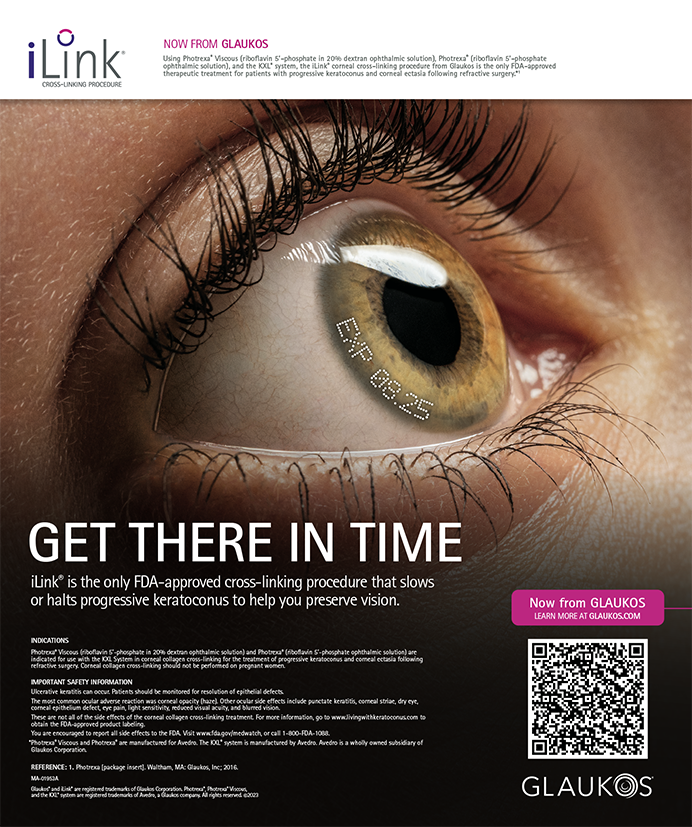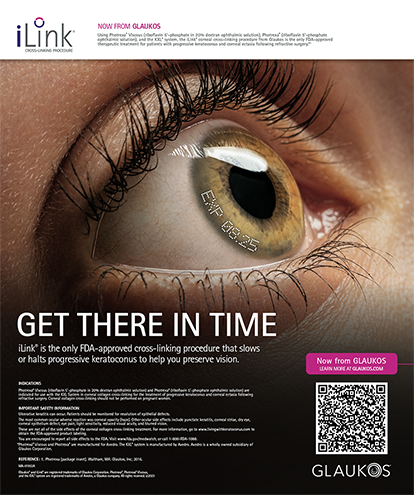Abnormalities of the iris and pupil may be preexisting, or they may occur during or even after cataract surgery (see Abnormalities of the Iris). Cataract surgery ceases to be conventional when the iris requires surgical repair. Although challenging to achieve, restoration of the iris is one of the most rewarding moments in anterior segment surgery.
FIVE CONSIDERATIONS
No. 1. Optical
There are five primary considerations when repairing an iris during cataract surgery. Optical considerations take into account the importance of pupillary shape and size regulated by the iris. An exceptionally large pupil is more likely to elicit complaints of blurred vision and glare. A very small pupil produces dim or “tinted” vision and approaches a diffractive-limited optical system. A small pupil can also limit the ophthalmologist’s visualization of the posterior segment, thus making it difficult to monitor other disease processes.
No. 2. Structural
Structural considerations involve the present and long-term integrity of the iris. A surgical injury to a healthy iris, for example, would be more amenable to suture repair than an iris that is highly atrophic from previous ischemia. In the latter scenario, suture erosion (ie, “cheese wiring”) would be more likely to occur.
No. 3. Functional
The surgical objective is to successfully address the patient’s complaints or condition in addition to the previous considerations (ie, preserving or reestablishing optical performance and structural integrity).
No. 4. Cosmetic
Cosmetic considerations vary based on the individual patient and iris color. “You are the apple of my eye”: this saying is a reminder not to underestimate the value of the pupil’s appearance.
No. 5. “Expectational”
As for any surgery, the ophthalmologist must help set reasonable expectations for the patient.
REPAIRING PREEXISTING IRIS PATHOLOGY DURING CATARACT SURGERY
Sutures
Repair strategies are largely guided by the extent of iris lost or damaged and the health of the remaining tissue. Patients can often tolerate defects covered by the upper eyelid with respect to glare and appearance, but sometimes, the superior tear meniscus contributes a prismatic effect that can make even small iridotomies symptomatic 1 When the iris root is healthy, defects involving less than 2 clock hours of damage are readily managed by a McCannel-style suture (10–0 polypropylene suture on a straight STC-6 or a curved CIF-4 needle [Ethicon]). Using the Siepser method of tying the suture reduces the need for intraocular manipulation.2 This technique is also useful for midstromal transillumination defects and iridectomy openings eyetube.net/?v=oofiw that need closure as well as for repairing iris defects resulting from the surgical removal of iris tumors. http://bit.ly/PagPHx. It is important to avoid suturing through highly atrophic iris tissue.
When suturing iris tissue, I use a liberal amount of a cohesive ophthalmic viscosurgical device (OVD). A dispersive OVD is retained better during phacoemulsification, however, and is also preferable when vitreous prolapse or the integrity of the posterior capsule is a concern.
Iris repair requiring anterior and/or posterior synechialysis is best accomplished with minimal surgical trauma. I use blunt dissection and viscodissection techniques to manipulate tissue and, when necessary, perform sharp dissection (http://bit.ly/1jQ727l)
The permanently dilated pupil can be elegantly repaired with a suture cerclage technique unless iris atrophy is extensive, frequently the case with long-standing dilation. Patients with deep-set eyes and a prominent nose may present anatomical challenges that are better handled with individual, interrupted sutures rather than cerclage.
Disinsertion of the iris root producing iridodialysis may be repaired using transscleral mattress sutures or the highly effective and elegant Hoffman pocket technique (http://bit.ly/NPKcgZ).3 Patients who have suffered more extensive trauma may require a multidisciplinary approach to manage the posterior segment as well as the cataract and iris defect (Figure).
Other Options
Large iris defects not amenable to suture repair may require the addition of a sector iris prosthesis or artificial iris, currently only available in the United States through a humanitarian device exemption or as part of a clinical trial.4,5 Cosmetic contact lenses that offer an artificial pupil are an option, but in my experience, they seldom fulfill patients’ expectations.
THE FLOPPY IRIS
It is rare for me not to encounter at least one patient on tamsulosin (Flomax; Boehringer Ingelheim Pharmaceuticals) during a busy surgical day. Preventing and limiting damage to the iris during cataract surgery on these patients is of great importance. Tamsulosin and other selective α-1 adrenergic blockers can cause poor iris dilation and intraoperative floppy iris syndrome (IFIS).6 Although tamsulosin is the leading offender, other drugs can also cause IFIS, including alfuzosin (Uroxatrol or Xatral; both from Sanofi Aventis), terazosin (Hytrin; Abbott), doxazosin mesylate (Cardura; Roerig), and even the over-the-counter herbal supplement saw palmetto. Of note, response is idiosyncratic, with some patients developing IFIS after limited exposure to one of these agents. Although most affected patients are male, women may also develop IFIS after using these medications for urinary retention or to help them pass kidney stones.
The best approach at this time is to obtain an accurate medical history and to evaluate patients at the slit lamp. I look for signs of atrophy and poor dilation during the examination. If the patient recently underwent cataract surgery on his or her first eye, I review the degree of pupillary dilation and whether or not IFIS was encountered during the first procedure.
It is helpful to maximize pharmacologic dilation prior to surgery and to minimize the size of the incision to reduce leakage and turbulence. A small incision is at increased risk of thermal injury, however, if the infusion line becomes constricted. I therefore strive for a large capsulorhexis and a slow, deliberate, low-turbulence procedure that takes advantage of maximum occlusion http://bit.ly/1jrRVxX. When necessary, I use iris hooks or the Malyugin Ring (MicroSurgical Technology).
CONCLUSION
Preventing injury to the iris during cataract surgery is important, as is not compounding a preexisting problem. OVDs can provide welcome protection during the cataract procedure and during the suturing of delicate iris tissue. An imperfect yet acceptable surgical outcome is guided by the five considerations and the principles discussed herein.
Alan N. Carlson, MD, is a professor of ophthalmology and chief, corneal and refractive surgery, at Duke Eye Center in Durham, North Carolina. He acknowledged no financial interest in the products or companies mentioned herein. Dr. Carlson may be reached at (919) 684-5769; alan.carlson@duke.edu.
- Spaeth GL, Idowu O, Seligsohn A, et al. The effects of iridotomy size and position on symptoms following laser peripheral iridotomy. J Glaucoma. 2005;14:5:364-367.
- Siepser SB. The closed-chamber slipping suture technique for iris repair. Ann Ophthalmol. 1994:26:71-72.
- Burk SE, Da Mata AP, Snyder ME, et al. Prosthetic iris implantation for congenital, traumatic, or functional iris deficiencies. J Cataract Refract Surg. 2001;27:1732-1740.
- Hoffman RS, Fine IH, Packer M. Scleral fixation without conjunctival dissection. J Cataract Refract Surg. 2006;32(11):1907-1912.
- Osher RH, Burk SE. Cataract surgery combined with implantation of an artificial iris. J Cataract Refract Surg. 1999;25:1540-1547.
- Chang DF, Campbell JR. Intraoperative floppy iris syndrome associated with tamsulosin. J Cataract Refract Surg. 2005;31:664-673.


